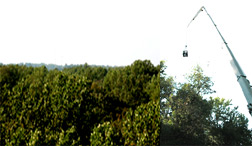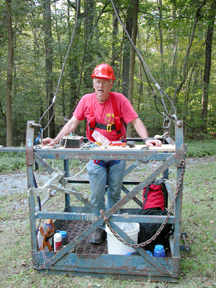|
Bay Life | Lead Story
What is a construction crane doing in the middle of a forest? Jess Parker will tell you that using a crane is a whole lot easier than climbing trees to see what’s happening in the forest canopy. Parker is the chief research scientist of the Forest Ecology Lab at the Smithsonian Environmental Research Center in Edgewater. On most days you can find him and his staff in the forest ecology lab or at one of their research sites in the center’s forest. But every now and then, you may find them in their “canopy crane office,” riding smoothly up through and high above the forest canopy. “The forest canopy,” Parker explains, “consists of all the living parts of a forest, the leaves, branches, twigs, as well as the stuff living on the surfaces.” The crane office looks rather primitive. It’s little more than a cage suspended with a cable from the arm of a construction crane, a piece of plywood fastened to one side of the cage to make a desk and a bunch of equipment wired and taped to the desk. What the scientists are doing with the equipment makes this office one of the most sophisticated around. The crane office is not a permanent fixture at the center. You’ll see it only when Parker rents a construction crane and sets up to do a specific study. On this day it contains two kinds of light meters and a portable laser system. Parker and his staff are using this equipment to map the rugosity of the forest canopy. Rugosity is a word that Parker has coined. It is based on the adjective rugose, which means “with creases, wrinkles or ridges.” Parker uses the word rugosity to describe the irregularity, or bumpiness, of a forest canopy. Swinging in a circle up to 16 meters wide, we are skimming over the tops of trees, 28 meters above ground. In his canopy office, Parker is taking light-meter readings. These readings, recorded continuously on this day from solar noon to sundown, will tell him how much light is being reflected back into the atmosphere in this part of the forest. That will help him learn more about the interface between the outer canopy and the atmosphere. Each forest, Parker says, has a unique topography. When you get above a forest, you can see the rugosity, the bumpiness, of that forest canopy. Basically, the bumpier the canopy, the older the forest. In a young forest, most of the trees grow up at the same relative speed as the competition for light keeps them working together. However, as the forest ages, some trees break away from the pack. Taller trees will take the light from the shorter ones, and faster growing species will outperform those growing more slowly. Soon older or suppressed trees will die and leave a hole in the forest canopy. Light can now penetrate through this hole all the way down to the forest floor. Holes allow smaller plants below to gather more light and grow faster. When you look at the canopy from above, you will see that there are dark places and light places. Parker hypothesizes that places in the canopy that are bumpy, or have more rugosity, have more holes and thus are less reflective than smooth places.  Slowly we descend through a hole in the canopy. Parker has picked an interesting one. “See that tulip poplar tree,” he says, “the one with the snapped off main trunk. See how it’s compensated, sprouting out new large limbs, taking full advantage of the hole.” Slowly we descend through a hole in the canopy. Parker has picked an interesting one. “See that tulip poplar tree,” he says, “the one with the snapped off main trunk. See how it’s compensated, sprouting out new large limbs, taking full advantage of the hole.”Parker orders the operator to take us down into the hole. We stop about two feet off the ground, at a spot littered with dead, decaying branches “This,” he grins, “is a perspective on the canopy we don’t often get to experience.” The light meter readings Parker is taking in his canopy office will help to test his hypothesis. On average, this forest reflects back 15 percent of the sunlight it receives. As with any average, however, the real amount of reflectivity will vary from place to place. For instance, within the dark, shadowed holes, less light is reflected back to the atmosphere, perhaps only a few percent, and more energy will be absorbed. Conversely, smooth places in the canopy ought to reflect back more light and absorb less. Rugosity could amount to large differences in energy available for growth or maintaining microclimates or habitats for forest organisms. If Parker’s hypothesis is correct, then the light meters should record less reflectivity when the crane passes over holes in the canopy and greater reflectivity when passing over the smooth parts. As we slowly ascend through the canopy, I notice more about its structure. How the tulip poplars with their large leaves often dwarf their beech and maple neighbors. When we get to the top again and then high above the canopy, I see the bumpiness, the rugosity, for what I have learned it signifies: a story of the forest dwellers, not the individual parts so much but rather all the parts working together as a forest canopy, in a constant competition for light, for life. |
© COPYRIGHT 2003 by New Bay Enterprises, Inc. All rights reserved.
Last updated November 26, 2003 @ 2:10am.


